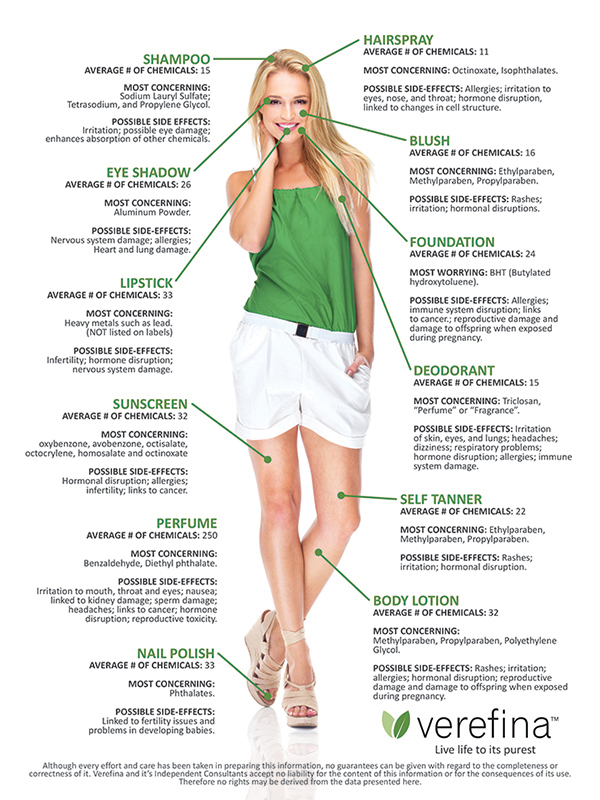Why You Won’t Find These 5 Ingredients in Verefina Products
Posted by Katie Zapotoczny on 30th Jan 2015
I was amazed to learn several years ago that the skin absorbs up to 60% of what is put on it. Sixty percent! So what we put on our bodies is just as important as what we put in them. And when you stop and think about it, most of us put a lot of stuff on our skin: lotion, soap, shampoo and conditioner, deodorant, shaving cream, sunscreen, and so on. We might also use a lot of these same types of products on our children, whose delicate skin can absorb even more than adults’ skin does.
Many people assume that the ingredients that go into body care products are all safe. Unfortunately, there is minimal regulation of the personal care industry. According to the Food and Drug Administration website:
The Federal Food, Drug, and Cosmetic Act (FD&C Act) does not authorize FDA to approve cosmetic ingredients, with the exception of color additives that are not coal-tar hair dyes. In general, cosmetic manufacturers may use any ingredient [emphasis mine] they choose, except for a few ingredients that are prohibited by regulation (source).
Because this industry is so loosely regulated in the United States, many companies are not compelled to avoid using ingredients that can negatively impact our health. It is therefore up to consumers to know what to look for and avoid in body care products. There are many commonly used ingredients that are associated with various health risks, and trying to avoid them all can be a daunting task. Fortunately, when you use Verefina’s products, you can be certain that they contain only safe ingredients. There are many synthetic chemicals that you won’t find in Verefina products; today I will focus on five of them.
Artificial Fragrances
The synthetic chemicals that are used to scent many products are considered "trade secrets," which means that manufacturers are not required to list the specific ingredients in them. Rather, they may simply use the word "fragrance" on the label. It is important to be aware that the term "fragrance" in an ingredient list could be code for dozens of chemicals (unless the label states what is in the fragrance). Many artificial fragrances give off volatile organic compounds (VOCs) that carry similar health risks- such as liver damage and cancer- to the VOCs released by household cleaners and paint stripers. They also cause allergic reactions in some people.
In contrast, Verefina uses essential oils, botanical extracts, and natural flavors to scent products.
Sulfates
Sulfates are detergents that make products foam. Most personal care products that get sudsy when you use them contain sulfates. Sulfates can irritate and inflame the skin and even cause layers of skin to separate. They also make the skin more permeable, allowing up to 40% more toxins to enter the body through the skin.
Sulfates can also strip away the natural oils produced by the skin. These oils are needed to help moisturize the skin, so it’s not a good idea to remove them. Continually removing these oils can also stimulate the skin to overcompensate and produce even more oil. This can lead to a cycle of stripping oils with detergents, which then leads to the overproduction of the skin's oils. Verefina’s sulfate-free soaps and cleansers don’t strip these oils, so they can help restore the skin’s natural balance.
The most common sulfates used in personal care products are sodium lauryl sulfate (SLS) and sodium laureth sulfate (SLES). But you won’t find them- or any other sulfates- in any Verefina product.
Triclosan
Triclosan is an antibacterial agent added to many hand soaps and some toothpaste. One of the concerns with triclosan is that it may not kill all bacteria, so the bacteria that survive may become resistant to it. Triclosan can also accumulate in the environment, especially in rivers and lakes. And some studies have linked triclosan to hormone disruption in animals.
The idea of killing bacteria on our hands sounds like a good idea. But the goal of hand washing should actually be to wash long enough and scrub hard enough to loosen microbes and rinse them away. Therefore, gentle, triclosan-free soap and water are all that is needed.
Parabens
Parabens are preservatives used in products such as shampoo, deodorants, cosmetics, lotions, and some foods and pharmaceuticals. They are used to kill bacteria, but may also be toxic to our cells.
Parabens may also function like estrogen once they are absorbed into the body. Estrogen is known to be associated with the development of some types of breast cancer, so it is important for the body to maintain a safe balance of estrogen; too much of it can be harmful. Parabens have been discovered intact in breast cancer cells. At this point, there have been no studies that have found a direct cause-effect relationship between parabens and breast cancer. But it is concerning that they do not appear to be easily broken down by the body.
Petroleum Products
Petroleum products, also known as mineral oil and paraffin, are derived from fossil fuels. They are often used to create artificial scents, and some carry moisture in products. Petrochemicals are very potent- some are added to paint and anti-freeze. These substances suffocate and age the skin. They also disrupt the skin's ability to eliminate toxins. The skin is an important pathway by which toxins leave the body, so it is important to avoid products that interfere with this vital function.
These ingredients, which are found in so many products, have a range of undesirable side effects. But when you use Verefina products, you don’t have to worry about any of them. Made with 99 or 100% natural ingredients, Verefina’s body care products are safe for everyday use by the whole family.

Sources:
Gavigan, Christopher. Healthy Child, Healthy World. New York: Penguin, 2009. Print.
Minnesota Bans Antibacterial Agent Triclosan
 About the Author
About the Author
Katie Zapotoczny is a Verefina Affiliate and the creator of An Ever Green Life, a blog that seeks to empower readers to make changes that will improve their health and help protect our environment.

